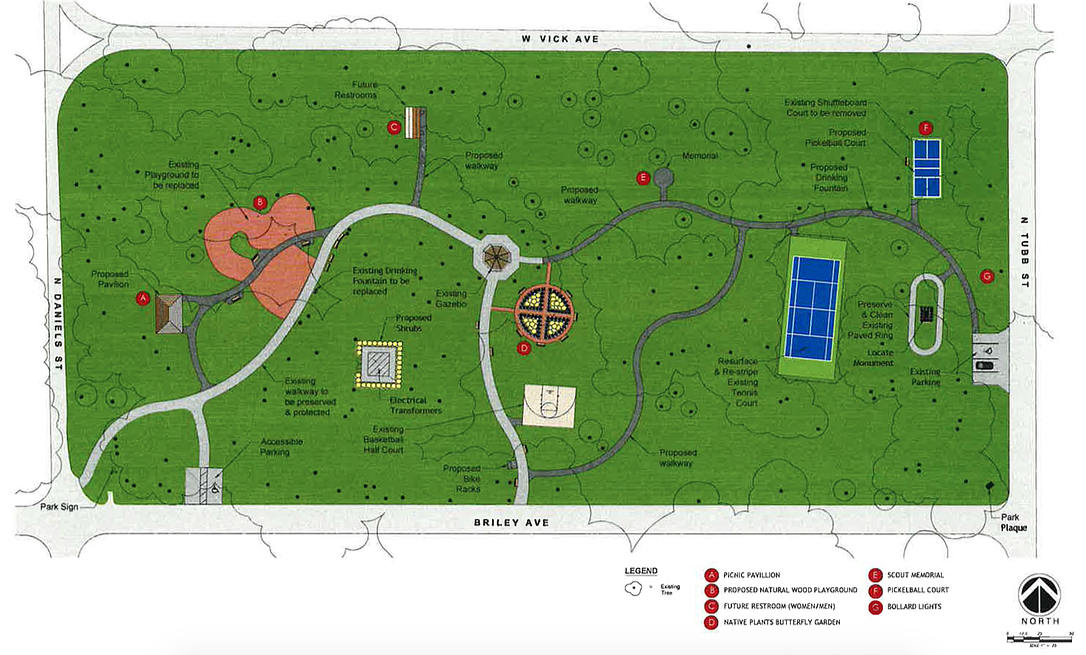- July 26, 2024
-
-
Loading

Loading

The Oakland Town Commission gave its nod of approval to the proposed master plan for Speer Park at its Feb. 25 meeting.
The town hired a consulting firm, CPWG, last year to help create the plan. In September, a community meeting was held to get input from residents regarding what they would like to see in the park. Recommendations were posted on large sheets of paper around the room, and attendees placed stickers on their top choices.
The town held a work session, and CPWG took the suggestions and provided a final draft.
Town Manager Steve Koontz said there will be no major changes to the 5-acre park.
“We are renovating and rehabbing what we have there,” he said.
A rendering of the Speer Park plan was presented to commissioners. Koontz said there are two changes: the space designated for future restrooms on the north side will be moved further east with a sidewalk extension veering off from the existing gazebo, and a junior baseball court will be built beside the existing half court on the park’s south side.
Koontz shared a list of recommended projects for the park, to be completed based on funding availability. These include an overall park maintenance plan, tree maintenance plus a replacement and planting plan, removal of old and broken furnishings and the addition of new ones, landscaping, updated signage, a butterfly garden, buildout of sidewalk plan, renovation of the tennis courts and new pickleball court, the addition of a pavilion to the west side, and bicycle racks.
The new pavilion will comply with the Americans with Disabilities Act, and Koontz said it will be located closer to the playground. The town still has to realize a lighting plan that is both considerate of neighbors and appropriate for security measures.
One of the bigger projects will be the replacement of the 18-year-old playground equipment, Koontz said. The town will need to research the most appropriate playground pieces before the purchase and installation. Residents had shared a desire for natural equipment rather than brightly colored pieces.
The park is considered a neighborhood park, so the main focus will be on amenities that draw Oakland residents and not the population at large on a daily basis. It still will be used for community festivals that typically also bring in residents from the surrounding communities.
The possibility of adding designated parking spaces was presented, but the consensus was that it’s a community park and most users will walk to it. Passive parking will remain on the north and west sides of the park for town events held in the park.
The commission gave Koontz authorization to move forward with executing the elements from the project list as funding allows.
Extra funds are available, according to Koontz. Parks and recreation impact fees that were going toward the Healthy West Orange Arts and Heritage Center have been redesignated after the West Orange Healthcare District donated $1 million toward the facility, now under construction near Town Hall.
Another piece of the park puzzle is a memorial planned by Eagle scout candidate Caleb Farr, but Koontz said this will be done independent of the town’s projects.
ARTS AND HERITAGE
The commission approved, in its consent agenda, the transfer of documents to the Winter Garden Heritage Foundation regarding the Healthy West Orange Arts and Heritage Center. Last March, the town and the WGHF executed a memorandum of understanding for support of Oakland’s arts and heritage center. The foundation has agreed to help facilitate exhibits once the center is finished.
Oakland officials have collected and inventoried 29 boxes of historic items and two oil paintings, which will be delivered to the WGHF’s History Research and Education Center under a one-year loan/storage agreement. Included in the terms of the agreement is that Winter Garden’s heritage foundation will use these items in future exhibits at Oakland’s arts and heritage center.
In addition, WGHF is returning to the town the second official minutes book from the mid-1900s to 1920s, to be stored with other municipal records.